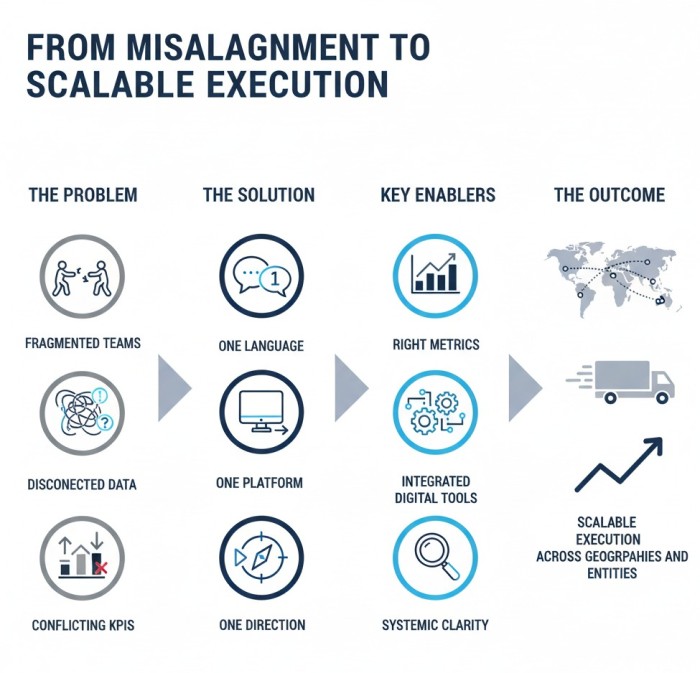Strategy Without Alignment Is Just Intent
You can have the best strategy in the sector—but without alignment, execution will fragment. In almost all industries, scale magnifies this problem: different teams, different sites, and different systems all pull in slightly different directions. Over time, this misalignment dilutes results, multiplies waste, and erodes trust. To scale transformation, you must first align the organization—horizontally and vertically.
Misalignment Is Often Structural, Not Personal
When cost control, maintenance planning, and production scheduling operate on disconnected data or conflicting priorities, the problem isn’t culture—it’s architecture. Field teams aren’t ignoring strategy; they’re often executing against outdated processes, disconnected dashboards, or conflicting KPIs. True alignment requires a systems approach, not just a motivational campaign. You fix the structure, and performance follows.
One Language, One Platform, One Direction
Cross-entity operations must speak the same language—financially, operationally, and digitally. That means harmonized naming conventions, shared master data, unified dashboards, and standardized reporting templates. When different parts of the business define “cost,” “failure,” or “completion” differently, no amount of leadership pressure can close the gap. Alignment starts with shared meaning, and shared meaning starts with shared systems.

Aligning Around the Right Metrics
What gets measured gets managed—but what gets mismeasured gets mismanaged. Organizational Alignment Framework shows that many industrial companies suffer from KPI overload or misaligned scorecards. Site-level goals conflict with corporate priorities. Maintenance success is defined by cost savings instead of availability. Strategic alignment means defining metrics that reinforce—not contradict—each other across functions and levels. The right metrics unite execution.
Digital Tools Can Accelerate—or Undermine—Alignment
Technology isn’t neutral. Poorly integrated systems introduce fragmentation, while well-designed platforms enforce clarity. When every department brings their own dashboard to a strategy meeting, alignment is impossible. But when ERP, BI, and analytics tools are configured around shared workflows, roles, and outcomes, alignment becomes operationalized. The tech either pulls you together—or pulls you apart.
Cultural Alignment Follows Systemic Clarity
Executives often ask: “How do we align our culture?” The answer begins with system clarity. When everyone sees the same numbers, reports in the same way, and follows the same processes, culture starts to converge. People trust what they see, and when they see coherence, they build momentum. Alignment isn’t about charismatic leadership alone—it’s about structural coherence delivered consistently. Learn more through the McKinsey 7‑S Model for Alignment.
Scalability Requires Alignment Before Acceleration
Without alignment, scaling transformation just scales confusion. As you roll out systems, processes, and policies across business units, alignment ensures consistency, traceability, and control. It allows your transformation to gain traction across geographies, entities, and asset types. In high-stakes sectors, scalable execution is impossible without enterprise alignment—and enterprise alignment begins with deliberate, architected clarity. Explore more in Aligning Strategy with Execution Framework and How to Achieve Strategic Alignment.
